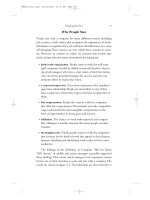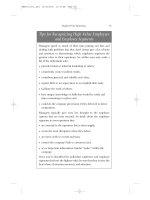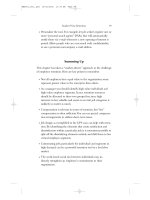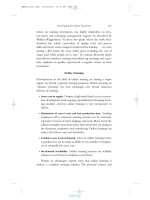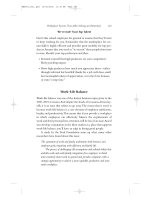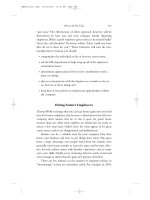Hiring and Keeping the Best People 19
Bạn đang xem bản rút gọn của tài liệu. Xem và tải ngay bản đầy đủ của tài liệu tại đây (117.31 KB, 8 trang )
the larger group, otherwise people may become isolated and out-of-
touch.
Telework clearly represents new challenges for managers, but the
benefits—especially in terms of work-life balance and retention—
can be substantial.
Flexible Work Schedules
Flexible scheduling is another mechanism for helping employees
achieve work-life balance. Flexible scheduling allows individual
employees to work something other than the usual 9-to-5, 40-hour,
5-day week. This creates opportunities for people to work even as
they accommodate the needs of young children, infirm relatives, and
so forth.
Many people favor flexible schedules.This is what the accounting
and consulting firm Deloitte & Touche learned when it surveyed its
professional staff—both men and women—in 1993. Eighty percent
said that they wanted greater flexibility in where,how,and when they
worked. The company responded the next year with programs for
both flexible work arrangements and parental leave.By 2000,approx-
imately nine hundred of the firm’s professional employees were
enrolled in one or another of these programs.
10
Did these programs
help retain professional employees? Clearly so. Eighty percent of the
individuals enlisted in the Deloitte & Touche programs reported that
they would have left the firm if the programs had not been made avail-
able. If you figure the average replacement cost of 720 Deloitte &
Touche professionals at 1.5 times annual salary (assumed here at
$75,000),the savings to the firm are roughly $81 million.
Here are some typical flex-schedule arrangements used in busi-
ness today:
•
Reduced-time schedules.
For example, an employee works from
10 to 5 in order to accommodate her need to drive her children
to school in the morning.
•
Seasonal schedules.
For example, a tax specialist works 60-
hour weeks from January through April to accommodate the
Workplace Factors That Affect Hiring and Retention 131
HBE001_ch6_.qxd 10/02/2002 11:36 AM Page 131
tax-filing crunch, then works 30-hour weeks for the balance of
the year.
•
Compressed schedules.
For example, to accommodate his
weekend acting vocation, a computer technician puts in 40
hours Monday through Thursday, leaving Fridays free for
rehearsals.
Flexible work schedules are appreciated by many employees.
More important, they expand the pool of potential employees. If
you define “who can work here” too narrowly—as 9-to-5, Monday
through Friday—you automatically exclude many otherwise quali-
fied people.Any hospital will confirm this. Desperate to recruit and
retain licensed nurses, most hospitals have expanded their hiring
pools through flexible scheduling. The first to do so differentiated
themselves from rival institutions.You can too. But first make a busi-
ness case for it.
Women as a Special Case
Everything said so far about the importance of work-life balance and
its enabling mechanisms is doubled if you are having trouble hiring
and retaining talented women. For reasons too numerous to discuss
here, women still bear the brunt of raising and caring for young
children and keeping the homestead running on an even keel—often
by choice.As Felice N. Schwartz once observed, majority of women
. . . are what I call career-and-family women; women who want to
pursue serious careers while partic pating actively in the rearing of
their children.”
11
Traditional work schedules and the demands of
business travel put these two goals in conflict.
It’s nearly impossible to manage the household if both parents
are “career primary.” And it’s still usually the woman who handles
the home front and the job.This is why flex-schedules, telework, and
similar programs are particularly appreciated by women. And since
women represent half of the talent in the world, it makes good busi-
ness sense to do what needs to be done to make their recruitment
132 Hiring and Keeping the Best People
HBE001_ch6_.qxd 10/02/2002 11:36 AM Page 132
and retention as easy as possible. So, if you don’t have work-life pro-
grams at your company, ask yourself:
•
What is our turnover among women in key positions, and how
does that compare with male turnover in the same positions?
•
In exit interviews, what have defecting female employees cited
as their reasons for leaving? Are they moving to firms with
work-life programs?
•
In our recruiting for those positions, what percentage of
women versus men has rejected job offers we’ve made? Was
work-life balance a factor in our offers being rejected?
If the answers to these questions point to clear problems in hiring
and retaining women, determine through research which—if any—
work-life programs would neutralize those problems.Then calculate
the cost/benefit relationship of these programs.
Summing Up
This chapter examined three “workplace factors” that can affect a
company’s ability to attract, hire, and retain good people:
•
Company culture:
Your company culture should be appealing
to the types of employees you want most to attract and retain.
Depending on the types of people you are looking for, you may
need to alter your culture to be more formal or informal,
relaxed or fast-paced. It should also be welcoming and as free as
possible from the internal conflicts that sour well-intentioned
people.
•
Employee burnout:
Burnout is an important workplace factor
to avoid. It can lead to lower job satisfaction, less commitment
to the organization, and defections.And talented people won’t
be eager to work for your company if it has a reputation as a
meat grinder.Watch for the several warning signs of burnout
and their root causes described in this chapter.You can avoid
Workplace Factors That Affect Hiring and Retention 133
HBE001_ch6_.qxd 10/02/2002 11:36 AM Page 133
or mitigate burnout through proper staffing, being sure that
people are adequately trained and prepared for their assign-
ments, prioritizing the workload, periodic redeployment,
and/or adding variety to employee assignments.
•
Work-life balance:
Work-life balance is a core element of
employee satisfaction, loyalty, and productivity. Find ways to
help employees successfully manage their commitments at
home and at work, and you will avoid many retention prob-
lems.And if your company develops a public reputation for
providing work-life balance, its recruiters will have an edge
over others in hiring good people.Telework and flexible work
scheduling are the two of the most effective tools for providing
work-life balance. Give them as much attention as you would
other aspects of hiring and retention.
134 Hiring and Keeping the Best People
HBE001_ch6_.qxd 10/02/2002 11:36 AM Page 134
Keeping Talented Employees, Even After They Leave
When All Else Fails
7
Key Topics Covered in This Chapter
•
Using alumni relations and informal
contacts to keep departed employees in your
company’s orbit
•
The benefits of rehiring former employees
•
Using exit interviews to uncover the root
causes of employee turnover
HBE001_ch7_.qxd 10/02/2002 11:44 AM Page 135
